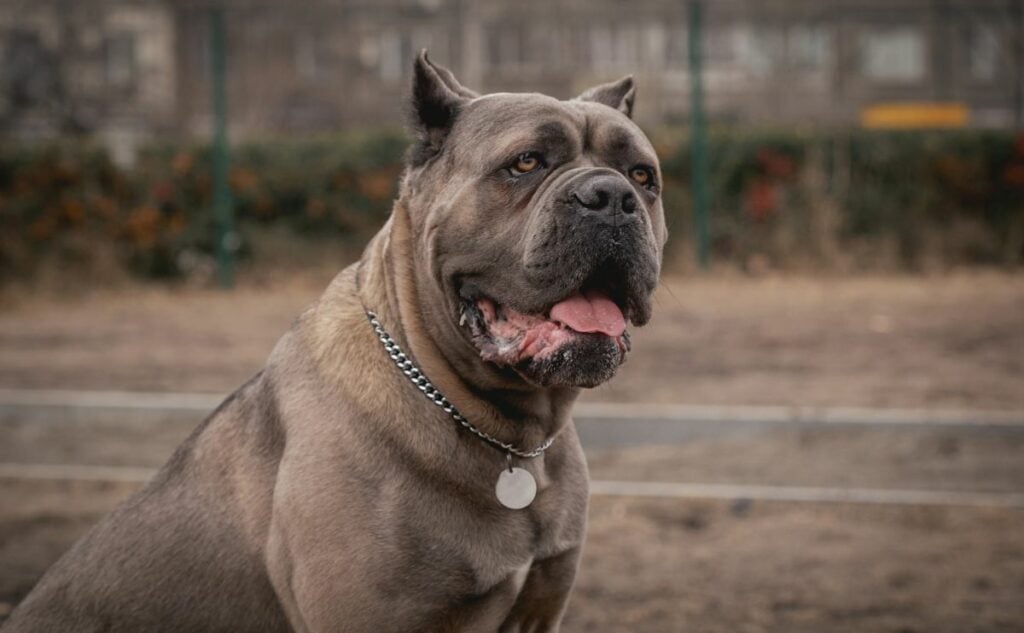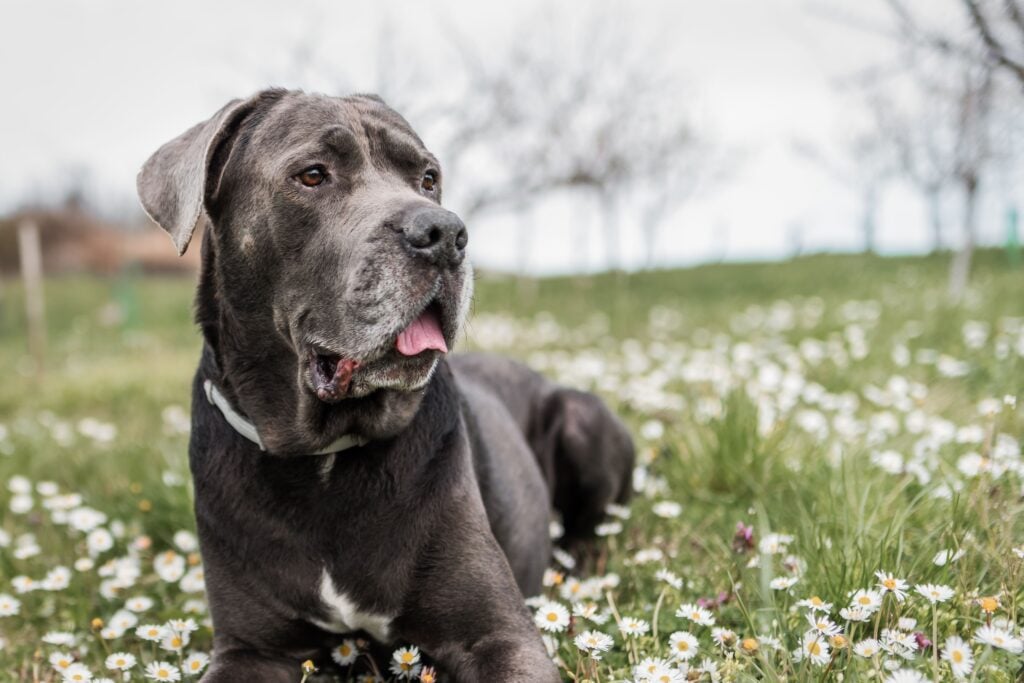Best Pet Insurance For Cane Corso Dogs
When you purchase through links on our site, we may earn a commission. Here’s how it works.

The Cane Corso, an Italian Mastiff breed, has become increasingly popular in the U.S. over the last few years. These large, powerful dogs are fiercely loyal and natural bodyguards. Cani Corsi (the proper plural of this breed) are highly intelligent, eager to please, and very trainable with an experienced owner. Despite their commanding presence, this breed isn’t immune to some troubling health issues.
Table of Contents
Hip dysplasia, gastric torsion, cranial cruciate ligament (CCL) tears, eye problems, epilepsy, and bone cancer are just a few of the major health issues that this breed is prone to. Taking care of your dog’s medical issues can be very expensive and emotionally taxing. However, pet insurance can allay these worries by paying a sizable percentage of your Corso’s veterinary bills.
I’ll walk you through the most common health problems Corsi face and the associated treatment costs, drawing on my ten years of experience with pet insurance and breed-specific health issues. I will also help you decide if pet insurance is a good option for your dog and offer my best recommendations for plans that best suit your requirements.
Best Pet Insurance For Cane Corso Dogs
Similar to all purebred dogs, the Cane Corso has specific pet insurance requirements. I’ve conducted extensive research on the most suitable pet insurance choices that cater to your breed’s needs. When selecting these insurers, I took into account various factors, including coverage and benefit options, breed-specific health concerns, a dog’s age, premium costs, and other significant details.
| Best For | Company | Get Quotes | Read In-Depth Reviews |
|---|---|---|---|
| Hip Dysplasia |  | Read Review | |
| Value |  | Read Review | |
| Unlimited Payouts | Read Review | ||
| Most Affordable |  | Read Review | |
| Cane Corso Puppies |  | Read Review | |
| Older Cane Corso Dogs |  | Read Review | |
| Vet Direct Pay |  | Read Review |
Best For Hip Dysplasia: Pets Best

- Policy Options: Accident-Only, Accident & Illness, Wellness
- Annual Deductible Options: $50, $100, $200, $250, $500, $1,000
- Annual Payout Options: $5,000, $10,000, Unlimited
- Reimbursement Options: 70%, 80%, 90%
Why I Picked Pets Best
Cane Corso dogs have a high prevalence of dysplasia, a hereditary condition that causes the joints to develop abnormally and bones to rub together, which is a cause for concern. It leads to pain, stiffness, and lameness, and many Corsi require expensive surgery to improve the quality of their lives. Many top pet insurance companies have 6-month waiting periods for hip dysplasia coverage, but Pets Best’s is only 14 days.
Pets Best stands out as an excellent option for Cani Corsi thanks to its extensive policies and competitive rates. They offer three tiers of accident and illness plans and various customizable choices for your deductible, reimbursement rate, and annual payout, allowing you to create a policy that suits your financial needs. Additionally, they are among the rare insurers that provide an accident-only plan.
Expert Price Analysis
When I compared Cane Corso quotes for multiple ages and locations, I found that Pets Best pricing was often either just below average or average. In many cases, its base plan at lower coverage ($1,000 deductible, 70% reimbursement, and $5,000 maximum payout) was among the most affordable compared to similar policies from other insurers.
| Pros | Cons |
|---|---|
| 14-day waiting period for hip dysplasia coverage is much shorter than average | Claim processing takes 18-30 days |
| Offers an accident-only and 3 accident and illness plans | Plan upgrades necessary for veterinary exam costs and complementary therapy* coverage |
| Save 5% when you insure more than one pet | Accident-only plan doesn’t cover CCL injuries |
| Covers pre-existing conditions that can be treated once they have healed | |
| 2 budget-friendly optional wellness plans to choose from | |
| No age restrictions for older dogs |
In-Depth Review Of Pets Best
Discover more about Pets Best’s plan options, waiting periods, wellness plans, reimbursement process, and other details by reading my comprehensive review of Pets Best.
Best Value: Fetch

- Policy Options: Accident & Illness, Wellness
- Annual Deductible Options: $250, $300, $400, $500, $700
- Annual Payout Options: $5,000, $10,000, $15,000
- Reimbursement Options: 70%, 80%, 90%
Why I Picked Fetch
If you’re looking for a comprehensive policy that provides excellent value, Fetch might be the perfect option to safeguard your Cane Corso from head to tail. Their plans have minimal exclusions and cover various services, such as veterinary examination fees, treatable pre-existing conditions, dental disease, complementary and behavioral therapies, and C-sections.
Additionally, Fetch offers unique perks that you won’t find with other insurance providers. These include $1,000 coverage for virtual vet visits, pet boarding if you require hospitalization, lost pet assistance, and more. Plus, with Fetch, you can benefit from the convenience of getting pre-approval for procedures and cost estimates prior to treatment.
Expert Price Analysis
Based on the quotes I ran for Cani Corsi, I found that Fetch’s premiums are highly competitive, particularly for younger Corsi. Considering the extensive coverage included in all policies, Fetch is a fantastic value.
| Pros | Cons |
|---|---|
| Excellent value for its wide coverage with few exclusions | Extended 15-day accident waiting period compared to average |
| Certain pre-existing conditions that can be cured are covered after a year without symptoms | Hip dysplasia and CCL coverage have 6-month waiting periods |
| Special benefits like pet boarding, trip cancellation insurance, and virtual vet visit coverage | Doesn’t provide a discount for multiple pets |
| Provides a wellness plan add-on | |
| Can approve procedures and estimates of treatment costs beforehand | |
| No age restrictions for older dogs |
In-Depth Review Of Fetch
Check out my thorough review of Fetch, where I delve into its distinctive coverage, customization options, reimbursement procedure, and additional features.
Best For Unlimited Payouts: Healthy Paws

- Policy Options: Accident & Illness
- Annual Deductible Options: $100, $250, $500, $750, $1,000
- Annual Payout Options: Unlimited
- Reimbursement Options: 50%, 60%, 70%, 80%, 90%
Why I Picked Healthy Paws
In light of the likelihood that your Cane Corso may experience unexpected accidents and expensive genetic health issues, you should investigate pet insurance plans that offer unlimited payouts. In many cases, Healthy Paws is an exceptional choice. This insurer offers a worry-free coverage limit because each policy has no annual or lifetime caps.
Although choosing unlimited payouts generally increases your premiums with most insurers, Healthy Paws’ pricing is often highly competitive. When comparing plans from other providers that also provide unlimited annual payouts with similar deductibles and reimbursement rates, Healthy Paws plans are often more affordable. Healthy Paws may even be a more cost-effective choice than policies with smaller payout limits for certain Corsi.
Expert Price Analysis
Healthy Paws only provides unlimited payouts, so comparing their premium costs to those of other insurance companies can be difficult. However, I found that their Corsi pricing is sometimes on par or slightly more expensive than other insurers’ policies offering a $5,000 payout and comparable deductibles and reimbursements.
| Pros | Cons |
|---|---|
| Features unlimited annual and lifetime payouts | Very limited customization options for many ages and locations |
| Affordable rates for comparable plans with no cap | Some Corsi ineligible for insurance coverage |
| Average claim processing is only 2 days | No coverage available for vet visit fees or behavioral therapies |
| 15-day waiting period for CCL coverage is much shorter than most insurers (6 months is typical) | Dogs who enroll at age 6 or older are not eligible for hip dysplasia coverage |
| Long history of satisfied clients | Lengthy 12-month hip dysplasia waiting period |
In-Depth Review Of Healthy Paws
I examine this provider’s coverage options, restrictions, customizability, waiting periods, and extra features in-depth in my review of Healthy Paws.
Most Affordable: Figo

- Policy Options: Accident & Illness, Wellness
- Annual Deductible Options: $100, $250, $500, $750
- Annual Payout Options: $5,000, $10,000, Unlimited
- Reimbursement Options: 70%, 80%, 90%, 100%
Why I Picked Figo
With plans that can be customized to meet your needs and budget, Figo provides comprehensive coverage at very reasonable prices compared to some insurers. You can add a wellness plan and vet exam costs if you want additional coverage. Figo is sometimes on the pricey side for many breeds, but that’s often not the case with Corsi.
Behavioral therapy, complementary therapy, dental illness, and C-sections are included in all Figo policies — items that many providers don’t cover or require additional fees. Furthermore, your deductible drops by $50 each year you don’t file a claim. For Cane Corso owners, Figo is an excellent option because of its quick claim processing and excellent customer service.
Expert Price Analysis
Figo often offered some of the most competitive premium prices for Corsi across various locations and ages. In particular, its base policy with low coverage ($750 deductible, 70% reimbursement, and $5,000 payout) was consistently among the most affordable plans compared to similar coverage from other providers.
| Pros | Cons |
|---|---|
| Policies with lower coverage are exceptionally affordable for Cani Corsi | Extra fee necessary for veterinary exam costs |
| 1-day accident waiting period is the shortest in the industry | Hip dysplasia and CCL coverage have 6-month waiting periods |
| All policies include coverage for complementary and behavioral therapies and dental illness | |
| Certain pre-existing conditions that can be cured are covered after a year without symptoms | |
| Wellness plan add-on available | |
| Diminishing deductible of $50 each year you’re claim-free | |
| Average claim processing is only 3 days | |
| Save 5% when insuring more than one pet | |
| No age restrictions for older dogs |
In-Depth Review Of Figo
Read my comprehensive review of Figo to learn more about what this insurer offers, including my personal experience, the reimbursement process, coverage details, and customization options.
Best For Cane Corso Puppies: Embrace

- Policy Options: Accident-Only, Accident & Illness, Wellness
- Annual Deductible Options: $100, $250, $500, $750, $1,000
- Annual Payout Options: $2,000, $5,000, $8,000, $10,000, $15,000, Unlimited
- Reimbursement Options: 70%, 80%, 90%
Why I Picked Embrace
Unlike many other insurers, which usually require pets to be at least eight weeks old, Embrace lets you enroll your puppy as early as six weeks. Thanks to a brief two-day waiting period for accidents, your little Cane Corso will be covered if they get hurt playing or swallow something they shouldn’t. Furthermore, Embrace offers some of the most comprehensive accident and illness insurance.
Each policy includes $1,000 for annual dental illness care as well as coverage for complementary therapies and behavioral therapy. Adding prescription medicine and veterinary exam fees further improves your coverage. Additionally, Embrace is an excellent option if you want to enroll your puppy for lifetime care because of its diminishing deductible.
Expert Price Analysis
Embrace consistently offered some of the most reasonable prices for Corso puppy insurance, based on my analysis of quotes. Embrace’s maximum coverage (unlimited payout, 90% reimbursement, and $100 deductible) for older Corso dogs was also very reasonably priced compared to other insurers’ policies with the same coverage.
| Pros | Cons |
|---|---|
| Among the most affordable premiums for Cane Corso puppies | Extra fees necessary for veterinary exam costs and prescription meds |
| All policies include complementary and behavioral therapies and $1,000 for dental illness | Some Corsi are ineligible for coverage due to age and location |
| Save 10% when insuring more than one pet | Hip dysplasia and CCL coverage have 6-month waiting periods |
| Your deductible decreases by $50 each year you don’t receive a claim payment | |
| Certain pre-existing conditions that can be cured are covered after a year without symptoms | |
| Average claim processing is only 5 days | |
| Offers several wellness plan add-ons |
In-Depth Review Of Embrace
You can learn more about this insurer’s benefits, multiple customization options, reimbursement procedures, waiting periods, and other details by reading my comprehensive review of Embrace.
Best For Older Cane Corso Dogs: Lemonade

- Policy Options: Accident & Illness, Wellness
- Annual Deductible Options: $100, $250, $500, $750
- Annual Payout Options: $5,000, $10,000, $20,000, $50,000, $100,000
- Reimbursement Options: 60%, 70%, 80%, 90%
Lemonade Pet Insurance Is NOT Available In: AK, DE, HI, ID, KS, KY, ME, SD, VT, WV, WY
Why I Picked Lemonade
Unfortunately, this breed is expensive to insure, particularly as they are nearing their senior years. However, Lemonade is an exception from many costly premiums for Corsi once they reach five years of age. With very competitive pricing for older Corsi, Lemonade could be your perfect option. It’s also a fantastic choice for younger pups. Thanks to its two-day accident waiting period, you can feel secure knowing that your dog is covered, especially in case they get hurt or swallow something they shouldn’t.
Please be aware that Lemonade does not insure all senior Cane Corso dogs. Depending on your location and your dog’s age, Lemonade may not offer coverage for your dog. For example, I obtained quotes for the same 8-year-old Cane Corso dog in California and Iowa. The dog in Iowa was eligible for coverage through Lemonade, while the dog in California was not. If your dog is not eligible for coverage through Lemonade, consider Embrace or Figo, as they offered competitive rates for older Corsi based on the quotes I obtained.
Also, Lemonade has a lower-than-typical coverage waiting period for hip dysplasia, a condition to which Corsi are particularly vulnerable. Thanks to its excellent customer reviews, Lemonade has gained popularity among pet owners despite being a newcomer to the pet insurance market, having only launched in 2020. I recommend looking into Lemonade’s offerings more closely, even though it doesn’t have the same established reputation as other insurers in this article.
Expert Price Analysis
When comparing Corsi quotes, I found that Lemonade had surprisingly lower premiums for those aged 5 and older. For instance, when using the same deductible, reimbursement, and payout, Lemonade’s premiums for a 5-year-old in Austin and an 8-year-old in Jersey City were less than half the cost of most other insurers.
| Pros | Cons |
|---|---|
| Among the most affordable premiums for Corsi older than 5 | Only available in 38 states and Washington, D.C. |
| Offers numerous customization choices for annual payouts, reimbursement rates, and deductibles | Additional premium expenses for dental work, complementary care, behavioral therapy, and veterinary exams |
| Save 5% when insuring more than one pet | CCL rupture coverage has a 6-month waiting period |
| Average claim processing is only 2 days | Doesn’t enroll some Corsi in specific states once they hit a certain age |
| Certain pre-existing conditions that can be cured are covered after a year without symptoms | |
| 2 affordable wellness add-on plans | |
| 30-day waiting period for hip dysplasia coverage (many have 6 months) |
In-Depth Review Of Lemonade
See my extensive review of Lemonade, in which I explore the many features, add-ons, optional preventative plans, and more offered by this provider.
Best For Vet Direct Pay: Trupanion

- Policy Options: Accident & Illness
- Lifetime Per-Condition Deductible Options: $0 – $1,000 (in $5 increments)
- Annual Payout Options: Unlimited
- Reimbursement Options: 50%, 60%, 70%, 80%, 90%, 100%
Why I Picked Trupanion
Having to pay your entire veterinarian bill out of pocket and wait for reimbursement is a pet insurance worry that some pet owners have, but Trupanion pet insurance addresses this issue. How? This insurer can pay your veterinarian at checkout, thanks to its VetDirect Pay feature. Your veterinarian can incorporate this easy-to-use software into their payment system. If your clinic does not accept VetDirect Pay, you can ask them to do so.
If you lack the funds to pay for costly veterinary bills, getting rid of the wait for reimbursement will ease your financial woes. Because Cane Corsi are prone to numerous expensive health issues, including hip and elbow dysplasia, inherited eye disorders, canine bloat, heart disease, bone cancer, and more, it is especially advantageous for them.
Expert Price Analysis
I found that Trupanion’s Corsi premiums were consistently substantially more expensive than those of other companies when I compared quotes for various ages and locations. This disparity frequently approached hundreds of dollars for older dogs.
| Pros | Cons |
|---|---|
| Features unlimited annual and lifetime payouts | Corsi premiums are much higher than those of other providers |
| Vet direct pay can alleviate having to wait for reimbursement | No coverage available for vet visit fees or behavioral therapies |
| Certain pre-existing conditions that can be cured are covered after a year without symptoms | Waiting period for illnesses of 30 days is longer than most |
| Average claim processing is only 2 days | |
| 30-day waiting periods for hip dysplasia and CCL coverage are shorter than average (many have 6 months) |
In-Depth Review Of Trupanion
To learn more about this provider’s benefits, customization choices, waiting periods, vet direct pay, and other features, see my in-depth review of Trupanion.
What Type Of Pet Insurance Plan Is Best For Cani Corsi?

There are generally two main types of pet insurance: accident-only plans and plans that cover both accidents and illnesses. Some providers also offer optional wellness plans to help you manage costs for annual checkups, lab work, and preventive treatments. While these wellness plans are not technically insurance, they can be a great way to ensure your furry friend stays healthy.
| Accident-Only | Accident & Illness | Wellness | |
|---|---|---|---|
| Injuries (gastric torsion, CCL tears, wounds, accidental poisoning, broken bones, etc.) | |||
| Diseases (hip dysplasia, eye disorders, cancer, epilepsy, mange, ear infections, etc.) | |||
| Preventative (annual vet exams, vaccinations, professional dental cleaning, etc.) |
What Are Accident-Only Pet Insurance Plans?
Plans that exclusively cover accidents are intended to assist with the expenditures of emergency medical care for pets that sustain unexpected injuries or mishaps. These can include things like foreign object ingestion, tears in the CCL, canine bloat, eye injuries, fractures, cuts, and more.
Accident-only plans are a great option for budget-conscious pet owners or for those whose pets have several pre-existing conditions that may not be eligible for a more comprehensive policy that covers both accidents and illnesses. However, these plans do not provide coverage for diseases or genetic issues. Furthermore, only a limited number of providers offer strictly accident-focused plans.
Pricing Tip – Accident-only plans usually have much lower premium costs compared to policies that provide coverage for both illnesses and accidents.
What Are Accident & Illness Pet Insurance Plans?
Accident and illness pet insurance plans offer comprehensive coverage for various medical issues, including physical injuries, illnesses, and genetic conditions like hip dysplasia, cataracts, and other diseases commonly found in this breed. With this type of insurance, you can be fully prepared to handle a wide range of health problems your dog may encounter.
What Are Wellness Plans?
Investing in a wellness plan is a smart choice for effectively managing your pet’s well-being. These plans help cover expenses related to routine preventive care, like yearly checkups, vaccinations, parasite prevention, dental cleaning, and more. By having a wellness plan in place, you can ease financial concerns and promote better health for your furry friend.
It’s critical to remember that wellness plans and pet insurance are different. Wellness plans only pay for preventative care; they don’t cover costs associated with accidents or illnesses.
What Does Pet Insurance Cover & Exclude?
The extent of pet insurance coverage depends on the policy type and the selected insurance provider. Generally, most accident and illness pet insurance plans include coverage for the items below when a veterinarian considers them medically necessary. However, it’s important to read each policy’s fine print, as this coverage may have specific limitations.
| Covered | Excluded |
|---|---|
| Blood tests | Boarding |
| Cancer (chemo & radiation) | Cremation & burial costs |
| CT scans | Elective procedures (e.g., declawing, ear cropping, spaying/neutering, tail docking, etc.) |
| Chronic conditions | Food & supplements |
| Congenital conditions | Grooming |
| Emergency care | Pre-existing conditions* |
| Euthanasia | Pregnancy & breeding |
| Hereditary conditions | Vaccines |
| MRIs | |
| Non-routine dental treatment | |
| Prescription medications | |
| Rehabilitation | |
| Specialized exams & care | |
| Surgery & hospitalization | |
| Ultrasounds | |
| X-rays |
Learn More About Pet Insurance Coverage
Understanding the nuances of coverage and exclusions can be challenging, so I recommend reviewing my detailed guide on what pet insurance does and doesn’t cover.
What Determines The Cost Of Pet Insurance For Cane Corso Dogs?

The place where you live, the age of your Cane Corso, each company’s underwriting guidelines, and other elements can all impact the price of pet insurance. Here’s a general overview.
- The age of your dog is a critical factor in determining the price of pet insurance. Premiums for older dogs are usually higher because they’re more likely to develop health problems than younger pups.
- The cost of living in your area plays a significant role in setting insurance premiums. It’s important to remember that higher living costs affect both you and your vet in the same way. Therefore, if you reside in an area with a high cost of living, you can anticipate that your vet bills and pet insurance costs will be higher.
- A dog’s breed is another important consideration for the cost of pet insurance. Certain breeds are more prone to health issues than others. Additionally, purebred dogs such as Cane Corsi tend to have more health problems, which can lead to increased insurance costs.
- Male Corsi might be more expensive to insure than females. This is because larger male dogs usually require more medication, medical equipment, and supplies. However, it’s important to note that not all insurance companies charge higher premiums based on the dog’s gender.
While you may not have control over some of the factors influencing your policy’s cost, numerous options are available to tailor your pet insurance plan to suit your specific needs and financial situation. Let’s examine how you can take advantage of these options.
Customization Options Affect Cost & Benefits
You may be surprised to learn that you play a crucial role in influencing the price of a pet insurance policy. Many pet insurance companies provide various options you can tailor to meet your budget and your pet’s health requirements. You can opt for a policy that covers only accidents or one that also provides coverage for illnesses. Additionally, you can adjust the deductible, reimbursement percentage, and the maximum payout. Understanding how these adjustments impact your benefits and coverage is essential.
What Is The Maximum Payout?
The pet insurance sector offers two categories of payouts: annual and lifetime. Annual maximum payouts represent the maximum amount an insurance provider will reimburse for your pet’s medical expenses within one policy year. In contrast, a lifetime cap refers to the total amount the insurer will pay for your pet’s care over the course of their insured lifetime. The companies discussed in this article provide annual payout options, commonly including $5,000, $10,000, and unlimited coverage.
Pricing Tip – Though smaller payouts result in a lower premium, they also increase your financial responsibility in the event that your Corso requires costly veterinary care, so you should carefully weigh your options before choosing a maximum payout.
Is The Deductible Annual Or Per-Condition?
The deductible refers to the fixed amount you’re required to pay before your insurance provider contributes to the costs associated with your dog’s veterinary treatment. Most providers mentioned in this article (and many others) have an annual deductible ranging from $100 to $1,000. Conversely, Trupanion has a deductible that’s applied on a per-condition basis. Here’s a brief breakdown of the differences.
- Annual deductible: The fixed amount that you pay for your dog’s insurance every policy year, regardless of how many health problems they may have or how many treatments they need. Because of this predictability, you can more easily manage and budget for your pet’s medical expenses.
- Per-condition deductible: Whenever your pet encounters a new medical issue or emergency, you’re required to pay your chosen deductible amount for that specific condition. This can add up quickly if your dog experiences multiple health problems within a single year. However, for ongoing chronic conditions like epilepsy, hypothyroidism, and heart disease, this deductible can be beneficial, as you only need to pay it once for each condition throughout your pet’s insured lifetime.
Pricing Tip – A policy with a lower deductible often results in a higher monthly premium.
What’s The Reimbursement Percentage?
The coverage provided by your insurance company for veterinary bills after you’ve met your deductible is influenced by the reimbursement rate you select. For instance, if you opt for a $500 deductible and an 80% reimbursement rate, you’ll pay the first $500 and 20% of the total veterinary expenses. Your insurance will cover the rest. Typically, reimbursement options are available at 70%, 80%, and 90%.
Pricing Tip – Choosing a higher reimbursement percentage will raise your monthly premium, but it will also reduce your out-of-pocket costs for treatment.
Learn More About Pet Insurance Costs
If you’re interested in more detailed insights about how different customization options impact your benefits, feel free to explore my in-depth article on pet insurance costs.
How Much Is Pet Insurance For A Cane Corso?
Please enter your zip code and provide details about your Cane Corso below to receive personalized pet insurance quotes from multiple highly-rated companies. This will ensure that you get the most accurate pricing for your furry friend.
According to NAPHIA (North American Pet Health Insurance Association), the average monthly premium for an accident and illness dog insurance policy in the U.S. is $62.44 ($32.10 for cats).
To help you better understand the average cost of pet insurance, I’ve gathered quotes for Cani Corsi of different ages and locations. These quotes consider similar customization options (deductible, reimbursement, and payout), allowing for a more precise comparison of premium prices across various providers.
| Company | 6mo old male 95818 (Sacramento, CA) | 1yr old female 14211 (Buffalo, NY) | 2yr old male 33604 (Tampa, FL) | 5yr old female 78731 (Austin, TX) | 8yr old male 07305 (Jersey City, NJ) |
|---|---|---|---|---|---|
 | $82.08 | $53.99 | $58.01 | $106.82 | $277.11 |
 | $117.27 | $76.00 | $92.81 | $170.03 | $259.80* |
| $82.87**§ | $58.04**§ | $71.10§ | $115.13**§ | $131.11†§ | |
 | $67.84 | $62.71 | $50.10 | $82.69 | $203.67 |
 | $60.25 | $71.37 | $52.64 | $96.63 | $146.43 |
 | $63.54 | $58.42 | $44.60 | $43.64 | $124.16 |
 | $177.44§ | $156.49§ | $562.95‡§ | $343.69§ | $671.23§ |
*80% reimbursement; **70% reimbursement; †50% reimbursement and $1,000 deductible (no other options); ‡$0 deductible; §Unlimited annual payouts
Cane Corso Insurance Cost: Lowest & Highest Amounts
Additionally, I’ve obtained quotes for the lowest and highest insurance premiums from the same companies to further analyze the cost differences. These quotes consider annual payout, reimbursement, deductible, and add-ons (excluding wellness plans). Furthermore, I’ve compared insurance costs for two different ages of Corsi, so you can see how the price of insurance changes based on a dog’s age when enrolling.
| Company | 2mo old 95818 (Sacramento, CA) | 5yr old 95818 (Sacramento, CA) | 2mo old 14211 (Buffalo, NY) | 5yr old 14211 (Buffalo, NY) | 2mo old 33604 (Tampa, FL) | 5yr old 33604 (Tampa, FL) | 2mo old 78731 (Austin, TX) | 5yr old 78731 (Austin, TX) | 2mo old 07305 (Jersey City, NJ) | 5yr old 07305 (Jersey City, NJ) |
|---|---|---|---|---|---|---|---|---|---|---|
 | $37-$228 | $52-$326 | $24-$154 | $34-$219 | $29-$185 | $40-$253 | $35-$198 | $48-$271 | $48-$275 | $65-$377 |
 | $76-$200 | $147-$391 | $52-$117 | $97-$223 | $60-$138 | $110-$258 | $63-$144 | $115-$266 | $61-$120 | $110-$221 |
| $55-$83 | $80-$121 | $49-$60 | Uninsurable | $41-$107 | $69-$191 | $67-$80 | $97-$117 | $57-$68 | $83-$99 | |
 | $30-$176 | $39-$229 | $26-$196 | $34-$255 | $21-$156 | $30-$226 | $23-$171 | $33-$248 | $38-$243 | $49-$316 |
 | $30-$234 | Uninsurable | $35-$218 | $36-$223 | $29-$136 | $38-$177 | $30-$196 | $39-$257 | $44-$205 | $57-$268 |
 | $35-$231 | $49-$321 | $39-$203 | $48-$245 | $29-$202 | $41-$288 | $35-$157 | $30-$148 | $46-$227 | $57-$278 |
 | $103-$454 | $217-$983 | $81-$350 | $141-$629 | $233-$431 | $498-$922 | $100-$437 | $202-$912 | $124-$549 | $258-$1,173 |
What Are Waiting Periods For Cane Corso Pet Insurance?
When you enroll in a pet insurance plan, the waiting period is the time it takes for your coverage to begin. The length of this period can vary depending on the insurance provider. Typically, the waiting period for accidents can range from 0 to 15 days, while for illnesses, it’s usually around 14 days. However, many insurers may impose longer waiting periods for orthopedic conditions such as hip dysplasia and CCL tears, which are common in Cani Corsi.
*States are gradually adopting a Model Law for pet insurance, aiming to standardize regulations, including uniform waiting periods. In California, Delaware, Louisiana, Maine, Mississippi, Nebraska, New Hampshire, Washington, Rhode Island, and Maryland, waiting periods are:
- Accidents: 0 days
- Illnesses: 14 days
- Cruciate Ligament Conditions: 30 days
- Routine Care: 0 days
Learn More About Waiting Periods
Find out the rationale behind waiting periods as well as other important details about pet insurance waiting periods.
How Does Pet Insurance For Cane Corso Dogs Work?

After the waiting periods mentioned in your policy have ended, using your pet insurance is simple.
- When your dog receives treatment, settle the bill with your veterinarian.
- To file a claim, you must complete a claim form and provide a detailed receipt to your insurance provider. Bring a copy of the claim form to your vet appointment, as some insurance companies require your vet’s signature.
- Once your claim is approved by the insurance company, you will receive your reimbursement* through your preferred payment method, such as a check, direct deposit, or another option.
* The time it takes to receive a reimbursement can differ quite a bit, ranging from just a few minutes to several weeks. This difference is primarily due to how long the company takes to process your request and the intricacy of your claim.
12 Common Health Issues In Cane Corso Dogs
The Cane Corso has a lifespan of 9 to 12 years. Even though their health is generally better than many other purebred breeds, they’re still likely to incur costly medical problems. Corsi owners must remain knowledgeable about possible health risks and the associated costs of raising this breed.
- Elbow and hip dysplasia, which occurs when the bones misalign with the joint socket, affects this breed at high rates. Surgery is often necessary, and the cost for each affected joint can range from $1,700 to $4,500 or more.
- Corsi are vulnerable to a life-threatening condition called gastric dilatation-volvulus (GDV), also called canine bloat or gastric torsion. GDV often develops when dogs eat too quickly, which causes the stomach to expand and twist. Dogs with GDV require immediate medical care, and costs can exceed $3,000.
- Cranial cruciate ligament (CCL) injuries are common in Corsi, even at young ages, because of their large size and high energy levels. A torn CCL in the knee frequently requires orthopedic surgery, which can cost $1,600 to $6,000 or more, depending on the severity.
- This breed is at high risk for several eyelid abnormalities, including entropion, ectropion, and cherry eye. Surgery is typically required to repair each abnormality, with costs ranging anywhere from $300 to $1,900 for each condition.
- Hereditary cataracts occur when the eye’s lens becomes cloudy. To avoid progressive vision loss, cataracts must be repaired surgically, which costs from $2,600 to $3,800.
- An aggressive and painful form of bone cancer called osteosarcoma is more common in large and giant breeds. This cancer spreads quickly, so early intervention is essential. Osteosarcoma diagnosis and treatment can be expensive, exceeding $10,000.
- Corsi are more likely to develop dilated cardiomyopathy (DCM), a heart condition that causes the heart to weaken and enlarge. In severe cases of DCM, surgery—which can cost anywhere from $10,000 to $20,000—is necessary to prevent heart failure.
- Demodectic mange frequently affects this breed. This type of mange occurs when Demodex canis mites overpopulate on a dog’s skin, leading to primary and secondary skin infections. In moderate to severe cases, oral and topical medications can range from $350 to $1,000.
- Corsi who don’t have cropped ears are more prone to developing ear infections. Every diagnostic test, prescription, and initial and follow-up vet visit could cost $500 or more.
- Hypothyroidism is a condition that arises when the thyroid gland doesn’t produce sufficient hormones. This means that ongoing testing and lifelong medication are required. Generally, the monthly medication cost ranges from $20 to $50. You’ll need to factor in initial diagnostic tests and annual retesting expenses, which fall between $50 and $150 per test.
- Idiopathic epilepsy is a common condition that leads to seizures in this breed. The annual cost for medication can be approximately $500, depending on the specific drug selected. Additionally, it’s important to factor in the expenses associated with diagnostic testing.
- The genetic developmental disorder osteochondritis dissecans (OCD) affects some young Corsi. OCD occurs when a joint’s cartilage separates from the bone, most commonly in the shoulder, knee, or ankle. Diagnosis and surgery could set you back more than $4,000.
Is Pet Insurance Worth It For Cane Corso Dogs?
Consider the statistics. According to the Orthopedic Foundation of America (OFA) 2023 testing statistics, more than 37% of Corsi were affected by hip dysplasia, almost 21% had elbow dysplasia, and over 7% experienced thyroid problems. Additionally, a report from the American College of Veterinary Ophthalmologists (ACV) revealed that close to 23% of Corsi had at least one eye condition.
It’s clear that this breed can face various health challenges that might lead to significant costs if you don’t have pet insurance. Pet insurance ensures that your Corsi receives top-notch medical care without worrying about hefty bills. It’s crucial to secure insurance for your dog before any health emergencies or hereditary issues come up. The sooner you get coverage, the better since many pre-existing conditions won’t be covered once you sign up.
Determine If Your Cane Corso Needs Insurance
I encourage you to read my detailed guide on whether pet insurance is worth it to help you determine if pet insurance is a good investment for your Corsi. It will help you evaluate all the pros and cons of getting dog health insurance.
5 Steps To Find The Best Pet Insurance For Cane Corso Dogs
Here are the crucial factors to consider when selecting the ideal insurance policy for your Corsi’s needs and your financial situation.
- Begin by looking into the reputations of different insurance companies. Established providers with a proven history are typically more reliable than newer ones.
- Familiarize yourself with all the health issues this breed may encounter and thoroughly examine each policy’s specifics to understand how each condition is addressed.
- Consider whether you prefer a plan that covers only accidents or a more extensive option that includes accidents and illnesses.
- It’s also important to grasp how each provider’s reimbursement process functions and the average time to process claims.
- Finally, obtain pet insurance quotes from at least three providers to most effectively compare their pricing.
Methodology
To determine the best pet insurance for Cane Corso dogs, we analyzed more than 40 U.S. pet insurance companies to provide an unbiased breakdown of how providers compare against one another. Our in-depth research includes:
- Running thousands of price quotes
- Reading hundreds of customer reviews
- Scrutinizing every policy from top to bottom and reading all the fine print
- Scoping out the purchase process
- Speaking with customer service representatives
- Having firsthand experience submitting claims with companies
- Comparing plan customization details
- Examining how long it takes to receive reimbursement
- Factoring in company history and years in the pet insurance marketplace
- Meeting with company representatives to discuss changes related to the industry, their company, and their offerings
- Requiring national experience for companies
Unlike many other review sites, we refuse to let pet insurance companies pay for the top spot in our rankings. Companies must earn their position in our comparisons by performing well in the marketplace. We also point out each company’s pros and cons in light of their competitor’s strengths. In doing so for over a decade, we’ve helped pet parents make more educated decisions among the top pet insurance options. Pet insurance providers read our reviews, regularly check them for accuracy, and value our input to help create positive industry changes and better protect your pets. We only recommend the best of the best because it’s what our readers deserve.
Additional Pet Insurance Resources
- Best Pet Insurance
- Is Pet Insurance Worth It?
- What Does Pet Insurance Cover?
- How Much Does Pet Insurance Cost?
- Best Pet Insurance For Pre-Existing Conditions
Why Trust Canine Journal?
Canine Journal has been covering the topic of pet insurance since 2012, well before other conglomerates discovered the rising popularity of health care for our pets. Many of our authors have personal experience with pet insurance, including Kimberly Alt, who has been Canine Journal’s go-to writer for pet insurance for over a decade, having written about nearly every possible facet related to pet insurance. Kimberly knows the subject so well that she can answer a breadth and depth of pet insurance questions immediately. And on the rare occasion she doesn’t know the answer off the top of her head, she can find it within minutes due to her vast list of resources. Kimberly also has extensive knowledge of dog health conditions, which can help her recommend pet insurance providers to pet owners with specific breeds.
Kimberly collaborated with Sally Jones, a seasoned health sciences communications professional with decades of experience. Sally specializes in dog health and is adept at producing content on technical topics such as pet insurance. Her wealth of knowledge and insight played a crucial role in this article’s thorough research and composition.
Kimberly also consulted with Michelle Schenker, Canine Journal’s in-house licensed insurance agent, for additional expertise to ensure accuracy and give Canine Journal the authority to write about and assist readers in purchasing policies that are accurately represented.



